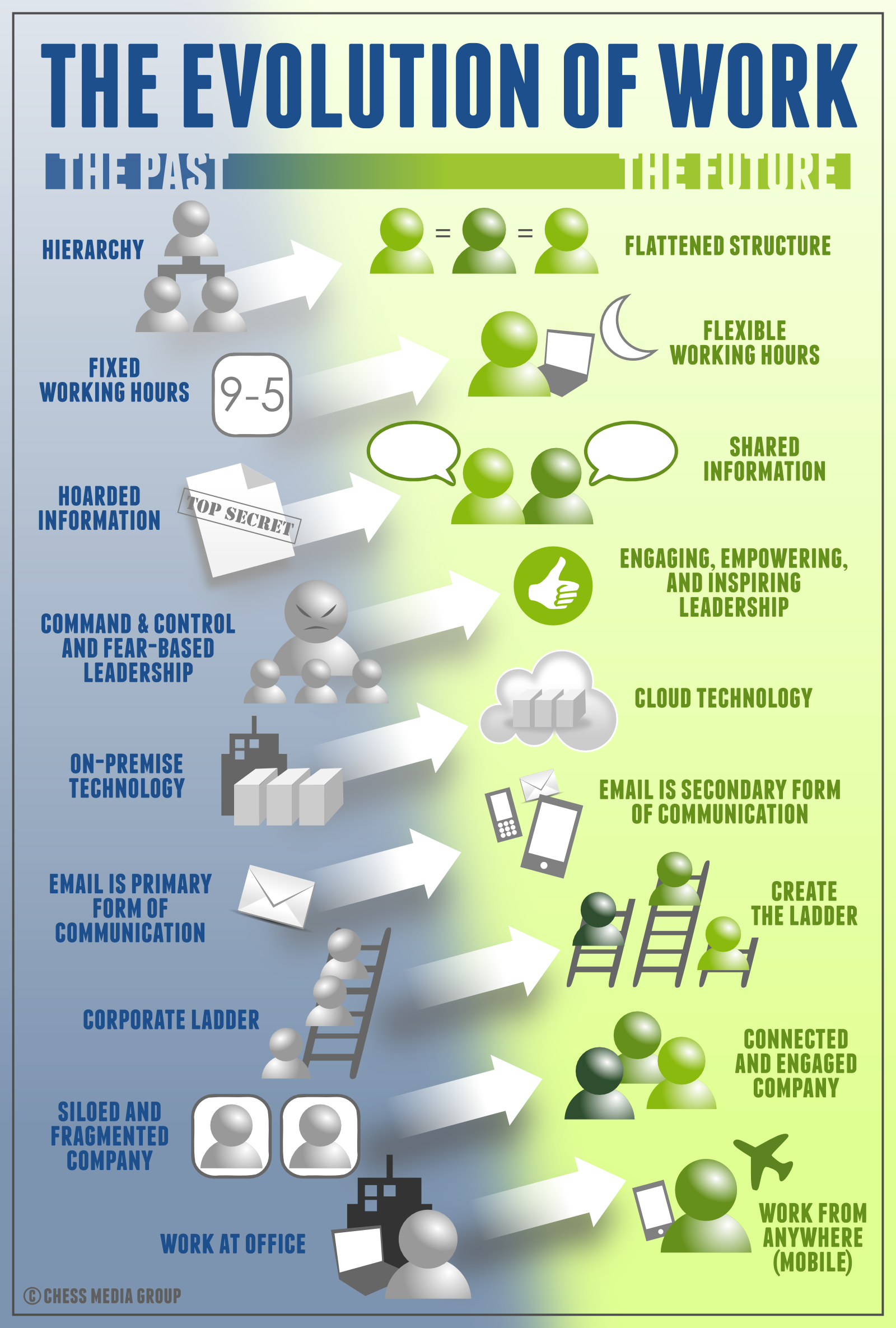
Jacob Morgan for Forbes © Chess Media Group
deutsch weiter unten
Infographic “The Evolution of Work” Jacob Morgan © Chess Media Group.
This might be the bright and shiny future, but at the moment I see a lot of obstacles and ressentiments to overcome. Plus, not at least, other problems like security issues etc.
Hierachy vs. Flattened Structures
Agree, we need to keep the communication and cooperation distances short to build powerful companies with great performing teams to develop the ability to react fast on changing tasks and challenges.
Fixing vs. Flexible Working hours
Yep, thats fine but only when there are core hours. We need reliable times to organize meetings etc. In the past I found companies where it was nearly impossible to meet because people came and go as they like it. Flexible is not: “Do what you want!”, flexible needs responsible employees.
Hoarded Information vs. Shared Information
A huge challenge to solve with well designed knowledge management arrangements. And, dear CIOs, managers, directors, HR guys, this could not be done with a installed intranet wiki. The implementation of a well working, sustainable knowledge management is really hard work.
C&C Fear-Based Leadership vs. Engaging, Empowering and Inspiring Leadership
Absolutely. Do you want subjects or creators, inventors, improvers, open minded employees with a huge interest to keep your company at the top? Excamples to fuind everywhere, just look araund, see and understand success stories.
On-Premise Tech vs Cloud Tech
Sorry, could not agree with this in general. Cloud technology is not save if you purchase external services, in fact it is also out of a companies control. Unless a company builds up their own, well secured cloud structure. And even than there are risks left. At last the persons using the cloud. It is possible but not really reasonable.
E-Mail is primary form of Communication - E-Mail is secondary form of Communication
Yes, yes and YES!
Business Practices That Refuse To Die #44: Email Trees and read Luis Suarez (http://www.elsua.net/2013/06/15/life-without-email-year-6-weeks-1-to-20-back-to-basics/)
Corporate Ladder vs. Create the Ladder
This needs really flexible organization. In my humble opinion, far to many companies are stepping in the “Peter Principle” trap (http://en.wikipedia.org/wiki/Peter_Principle). And this is not just a waste of potential and energy, this bears the potential to let a company fail completely. No organization need competency simulators. Not easy to solve in times of social networks, virtual influencer charts (such a bloody mess) etc. But a must!
Siloed and Fragmented Company - Connected and Engaged Company
Absolutely. But to transform a more “traditional” company, there are many obstacles to overcome. Some are very similar to the barriers to throw down while a company tries to implement some seriously knowledge management.
Work at Office vs. Work from Anywhere
Today it is easier then ever. But I’ve seen to many excamples where this went nuts, so it need a good strategy and very disciplined employees. In addition, there are some other points to think about (please scroll ⇑).
~~~~~~~~~~~~~~~~~~~ deutsch ~~~~~~~~~~~~~~~~~~~
“The Evolution of Work” Jacob Morgan © Chess Media Group.
So könnte die schöne neue Zukunft aussehen, aber im Moment sehe ich noch einige Hindernisse und Widerstände, die zu überwinden sind. Nicht zuletzt auch Sicherheitsprobleme etc.
Hierachien vs. Flache Strukturen
Unbedingt. Wir müssen die Kommunikations und Entscheidungswege kurz und eindeutig halten. Nur so werden Unternehmen und deren Teams in der Lage sein, schnell wechselnden Herausforderungen angemessen zu begegnen.
Feste Arbeitszeiten vs. Flexible Arbeitszeiten
Wunderbar. Allerdings nur dann, wenn es Kernarbeitszeiten gibt, in denen Meetings und Ähnliches organisiert werden können. Ich habe Unternehmen erlebt, in denen jede/r machte was er/sie wollte. “Flexibel” heißt nicht “Tu was Du willst.”! “Flexibel” benötigt verantwortungsbewusste Mitarbeiter.
Gehortete Informationen vs. Geteilte Informationen
Das ist eine große Herausforderung für jede Organisation. Wirklich gut durchdachte und eingeführte Wissensmanagement-Vorhaben können hier helfen. Liebe Geschäftsführer, Manager, Personalverantwortliche, die Einführung eines guten unf funktionierenden, das heißt auch akzeptierten Wissensmanagement ist aufwändig. Mit einem im Intranet installierten Wiki ist es bei weitem nicht getan.
Angstbasierte Führung vs. Engagierter, inspirierender, deligierende Führung
Dem kann ich nur zustimmen. Wollen Sie Untertanen? Kleine Schleimer und Kriecher die Ihnen nach dem Mund reden? Oder werden vielleicht engagierte, mutige Mitarbeiter, die sich nicht scheuen neue Wege zu gehen, neuen Herausforderungen entgegen zu treten? Gescheiterte, feudal geführte Unternehmen gibt es in Massen. Schauen Sie sich einmal die Erfolgsgeschichten der führenden Unternehmen an.
Eigene Infrastruktur vs. Cloud-basierte Dienste
Hier kann ich nur bedingt zustimmen. Extern eingekaufte odr gemietete Cloud-Technologie ist nicht sicher. Außerdem verlieren Firmen die Kontrolle über ihre Anwendungen und Daten. Eine mögliche Lösung wäre der Betrieb eigener Server und Cloud-Dienste und salbst da bleiben Risiken. Nicht zuletzt die Anwender. Cloud ist möglich, wirklich sinnvoll eher selten.
E-Mail als Hauptkommunikationsform - E-Mail als zusätzliche Kommunilationsform
Ja! Unbedingt!
Business Practices That Refuse To Die #44: Email Trees und lesen Sie Luis Suarez (http://www.elsua.net/2013/06/15/life-without-email-year-6-weeks-1-to-20-back-to-basics/)
Firmenhierarchie vs. selbstgemachter Aufstieg
Voraussetzung ist eine sehr flexible Organisation. Meiner Erfahrung nach schlägt in zu vielen Organisationen das Peter Prinzip zu (http://de.wikipedia.org/wiki/Peter-Prinzip). Und damit wird nicht nur viel zuviel Potential und Energie verschwendet, es birgt die Gefahr, das ein Unternehmen komplett gegen die Wand gefahren wird. Keine Organisation kann sich Kompetenz-Simulanten erlauben, das in Zeiten sozialer Netzwerke, virtueller “Influencer” Hitparaden (so ein Müll) nicht einfach aber wichtig.
Isolierte und fragmentierte Organisationen - Eingebundene, engagierte Organisationen
Unbedingt. Um ein eher “traditionelles” Unternehmen entsprechend zu transformieren, sind viele Hindernisse zu überwinden. Viele sind durchaus mit jenen Barrieren vergleichbar, die bei der Einführung von Wissenmanagement einzureißen sind.
Arbeiten im Büro vs. Arbeiten überall
Das ist heute einfacher als je zuvor. Allerdings habe ich zuviele Beispiele erlebt, in denen das gründlich schief gegangen ist. Um das erfolgreich einzuführen bedarf es eine soliden Strategie und sehr disziplinierter Mitarbeiter/innen. Auch sollten einige andere Dinge Beachtung finden (bitte mal ⇑ scrollen).
via Jane Hart
#transformation #organization #bravenewworld
 My Quote of the day. John Stepper1 asked Seth Godin2
My Quote of the day. John Stepper1 asked Seth Godin2